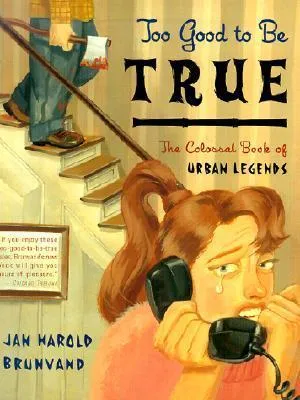Too Good to Be True: The Colossal Book of Urban Legends
By (author): "Jan Harold Brunvand"
ISBN0965010492
AsinToo Good to Be True: The Colossal Book of Urban Legends
Original titleToo Good to Be True: The Colossal Book of Urban Legends (Paperback)
Have you heard the one about the new computer owner who mistook the CD-ROM player for a cup holder? Or the woman who thought her brains were oozing out of a gunshot wound, when the "truth" was that when her Pillsbury Poppin' Fresh can exploded, striking her on the head with the lid, the goo she felt was biscuit dough? Jan Harold Brunvand, professor emeritus at the University of Utah and author of numerous urban-legend collections, including The Vanishing Hitchhiker, The Choking Doberman, Curses! Broiled Again, and American Folklore: An Encyclopedia, has been studying urban legends for some 20 years, and his new book, Too Good to Be True, relates more than 200 of these indestructible tales. There are relatively recent stories based on modern technology, such as the classic microwaved pet, and yarns that have been making the urban-legend circuit for decades, such as the solid-cement-Cadillac story, which can be traced back to the 1940s, at least, involving a cement-truck driver who spies a new Cadillac convertible in his driveway and his wife talking to some strange man. He dumps his load of concrete on the Cadillac, but later discovers the stranger was a car dealer and the car was to be a gift from his wife, one she'd spent years saving her pennies for. The stories are grouped by subject, including "Dog Tales" and "Just Desserts," "Sexcapades" and "Losing Face." There are baby stories and work stories, criminal tales and college anecdotes, plus stories of mistaken identity, human nature, and technology. Brunvand achieves more, however, than a mere compendium of highly entertaining stories. He discusses the nature of urban legends--those almost believable, addictively retellable tales that always happened to a friend of a friend (FOAF, in folklorist parlance)--and for each individual story, Brunvand includes as much of its history as he has been able to trace, including newspaper accounts, alternative versions, and the story's natural cycle, that is, how many years, typically, between resurfacings. The result is an exceptionally engaging book and a great resource for debunking that next story, as heard from a friend by that unnamed acquaintance of unassailable honesty, that sounds just a little too perfect to swallow whole. --Stephanie Gold

